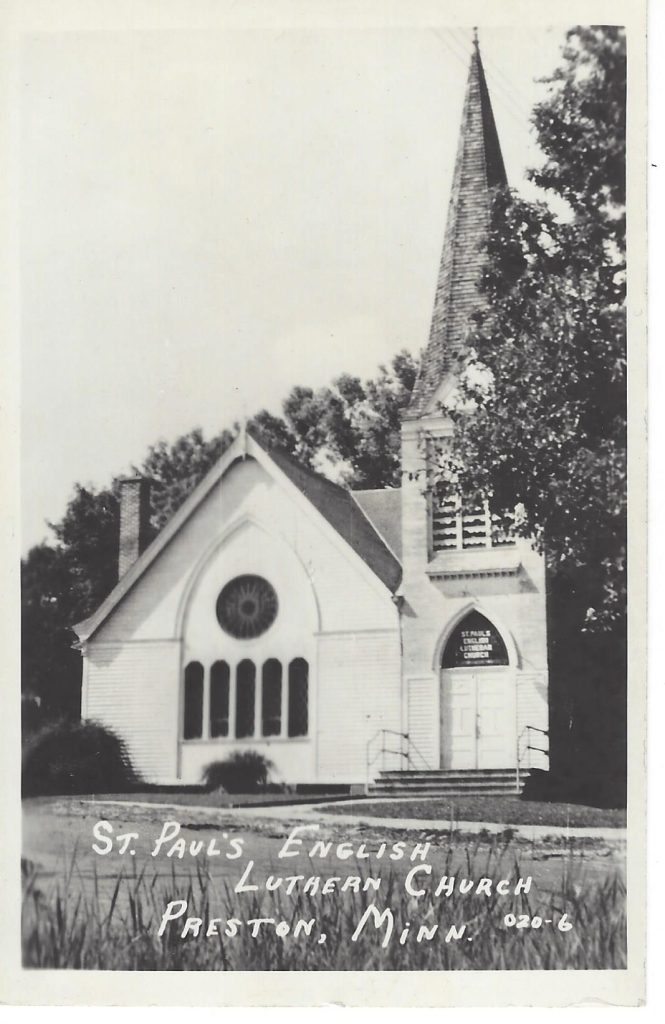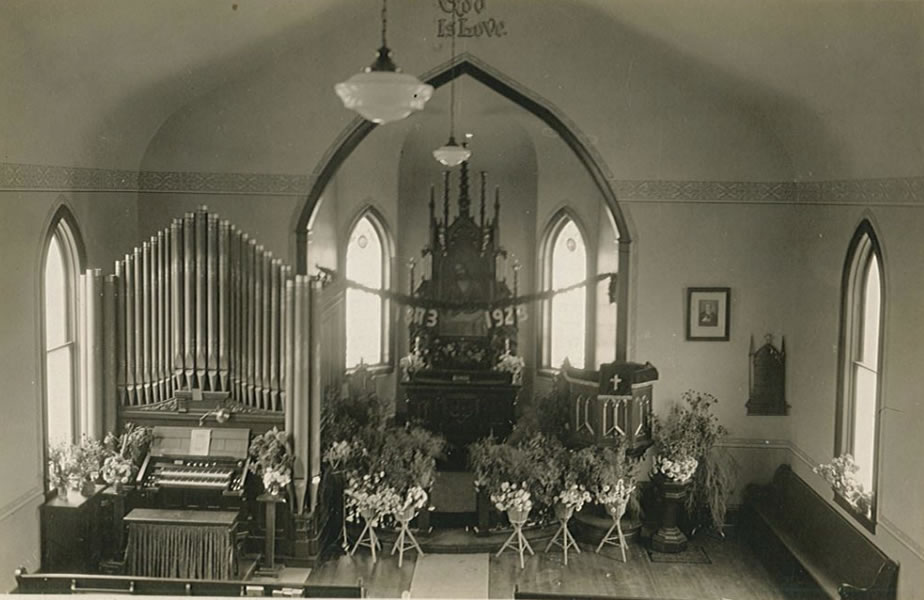
History of Christ Lutheran Church
St. Paul’s American Lutheran Church
(German)
- S. Hertrich (1873-1886)
- Big Spring rotating pastors – O. Harmann, F. Keuthe, and W. Nolting (1875-1886)
- C. Hast (1886-1903)
- J. Burkhardt (1903-1905)
- H. Mueller (1905-1908)
- Paul Kumpf (1908-1918)
- J. Krueger (1918-1921)
- Gerhard Bunge (1922-1926)
- Ernest G. Gaede (1926-1953)
- Alvin Fritschel (1953-1957)
- Richard Lafer (1957-1958)
St. Paul’s Evangelical Lutheran / Grace Lutheran (Norwegian)
- E. Thuland (1887-1889)
- H.E. Rasmussen (1890-1915)
- P.J. Nerstrande (1915-1946)
- Richard Vordale (1947-1956)
- Philip Hansen (1956-1958)
Christ Lutheran Church
Senior Pastors
- Rolf Boe (1958-1961)
- Obed Nesheim (1961-1965)
- Walter Wahl (1965-1977)
- Roger Herfindahl (1977-1984)
- John Heruth (1984-1992)
- Leon Stier (1992-1996)
- Harold Deye (Interim 1997)
- James Rushton (1998-2010)
- David Jore (Interim 2010-2013)
- Dan Bredberg (2014-2022)
- Scott E. Olson (Interim October 2022-July 2023)
- Kris Hertsgaard Kincaid (Sept. 2023 – current pastor)
Timeline History of Christ Lutheran Church

Rev. M. Reck of Spring Valley began conducting services for a small group of German Lutherans in Preston. Not having a church, they met in one of the rooms of the county courthouse which had just been built in 1865. Those pioneer days were trying for both pastor and people. Folks had to face adverse weather and roads, often going the distance on foot. Their determination speaks to the commitment and faith to come together for worship.
St. Paul’s American Lutheran Church was formed by a group of Preston Lutherans known as the German Lutheran Society. At the time, there were 14 charter members, services were only in German. The parsonage was located in Big Springs, the pastor conducted services in Preston, Big Springs, and Granger.
St. Paul’s American Lutheran Church
Under the direction of Rev. S. Hertrich who took over the work of Rev. Reck, the German congregation was able to build their first house of worship. Eventually a parsonage would be added next to the church (in 1886). We do not have a photo of this first building at this time.
A second “St. Paul’s” appeared in the community when St. Paul’s Evangelical Lutheran Church was formally organized by the “other stream of Lutherans” in the Preston area on Feb. 7th, 1887; most of whom were of Norwegian ancestry. Rev. E Thuland served as pastor and the congregation consisted of six families. They did not have a church building of their own but worshipped at the St. Paul’s German Lutheran Church at a very reasonable rental.
The first few months after the organization, the new congregation enjoyed comparative prosperity but due to unforseen difficulties which developed in the whole parish, the new congregation was nearly wrecked. (information taken from the 1937 Fifty Golden Years booklet) In 1890, Rev. H. E. Rasmusson accepted a call to serve until 1915.
St. Paul’s Evangelical Church congregation built their own church and the dedication service was held on Dec. 18, 1895.

Mr. S. Langum, the first secretary of the congregation and editor of the Preston Times gave a splendid description of the church and dedication service. The morning service was in the Norse language and the evening service was in English.
“The new St. Paul’s Church is now completed in every detail, with the exception of a finishing coat of paint on the outside which, due to the late season of the year, must be postponed until the spring. the church was designed by Architect Osterud of Spring Valley, Minnesota, and is modern in every respect. The building is practically square, about 45×45 feet, measuring from floor to center of ceiling 20 feet in height, and from foundation to the top of the spire 75 feet. The pews are finished in circular oak, manufactured by the Grand Rapids School Furniture Company at a cost of $400. the inside decorating was done by Wenneson & Hector, local painters, and is pronounced one of the finest in this section of the state. There are twenty windows, including two large circular ones, all leaded glass, tastefully designed and were furnished by Brown & Heywood of St. Paul, MN. The furnace is of Winona make, furnished by Bennett & Heinrich and is at present the largest furnace in the village. Mr. Ole C. Ask of Lanesboro has done all the carpenter work, and has done it well and faithfully. The complete structure has been erected at a cost of $3,000. Regardless of nationality or creed, our Preston people have donated liberally.”
St. Paul’s American Lutheran Church (German)
By the grace of God, the congregation grew to such an extent that in 1903, the first church proved too small. During the same year, a new and larger church was built at the cost of $4,000. Rev. J. Burkhardt also began his pastorate this same year.


Confirmation Class
Back row: Minnie Joseph, Maggie Dahly, Winnie Joseph, Anna Bender Marzolf, and Emma Groth.
Middle row: Henry Kruegal, John Neumann, Rev. Burkhardt, and Frank Huldhusen.
Front row: Louise Hanning Anstett and August Ristau.
(German Lutheran Church)
Name Change
St. Paul’s Evangelical Lutheran Church changed its name to St. Paul’s English Lutheran Church. It was also known as “St. Paul’s on the Hill,” and at this time, English became the official language of the church. Until then, it was a bi-lingual church, with members speaking English and Norwegian.

Pipe Organ-Norwegian Church
Excerpt from the Fifty Golden Years Booklet:
“Through the initiative of Mr. Ben Skaugerud, a two manual Kilgen pipe organ was installed and dedicated in the month of March, 1917. The first two hundred dollars on the subscription list was given by Mr. Skaugerud and Nels J. Lien. Besides the cash subscriptions raised, the ladies of the church added several hundred dollars to the organ fund, which was paid in full at the time of the purchase. New choir seats were also purchased at this time.”
Celebrating 50 Years…
Sanctuary decoration for the fifty year celebration (German)


Ladies Aid – German Church
The Ladies Aid groups of both churches deserve recognition and much more description of their mighty efforts and generosity. More to come!

St. Paul’s German Lutheran Church added a modern basement at a cost of $1,500.
St Paul’s (German) started holding services entirely in English.
(Art glass windows were installed at a cost of $800)

Name Change
To eliminate confusion between the two churches, St. Paul’s English Lutheran Church changed its name to Grace Lutheran Church. Despite the change, many still called it “St Paul’s on the Hill,” while the other St Paul’s was referred to as the “German Lutheran Church.”

The first meeting was held between St. Paul’s (German) and Grace Lutheran (Norwegian), to discuss a potential merger of the two congregations. Both congregations had outgrown their facilities.
Each church was a member of a separate synod – St. Paul’s as part of the American Lutheran Synod (ALS); Grace as part of the Evangelical Lutheran Synod (ELS).
During the meetings, Norwegians sat on one side and Germans sat on the other.
Farsighted congregational leaders of the two churches began to consider uniting their congregations and building one new building.
The Norwegian church officially invited the German church to begin merger negotiations.

On Sunday afternoon, June 1, 1958, members from the two Lutheran churches marched from their separate churches and joined together at the Preston High School.
Rev. Richard Lafer, left, pastor of St. Paul’s Church, and Rev. Philip Hansen, right, pastor of Grace Lutheran, meet at the street corner on June 1, 1958. The two pastors would lead their congregations to Preston High School for the first combined service.

Through their march, the hymn “A Mighty Fortress is Our God” was sung and played by members of the high school band, and each church building tolled its bells. Upon arrival at the school gymnasium, a vote was held, and members voted unanimously to merge as one. (Jeanette Schmidt shared she recalled playing in the HS marching band for this event)
The name of Christ Lutheran Church was chosen.
Listen to “A Mighty Fortress is Our God”
For the time being, while the new church building was under construction, services would be held in each of the other churches, alternating weekly. (Marilyn Bunge shared that they alternated churches at first but that the German church was larger and eventually most of the services were held there.)
As Christ Lutheran was not a member of either parent synod, it supported the work and mission of both synods.
Rev. Rolf Boe, the first pastor of the combined Christ Lutheran Church.
As agreed upon during the merger, the pastors from each church, Rev. Richard Lafer and Rev. Philip Hansen, both resigned once the merger was complete.


Groundbreaking of the new Christ Lutheran Church building.
Pictured are members of the Building Committee: Gerald Schmidt, Mrs. J.P. Nehring, Mrs. A.M. Chilson, John Turck, Fred Veglahn, Arnold Hellickson, Arnold Kruegel, and Ted Severson.

The parent synods, the American Lutheran Synod and the Evangelical Lutheran Synod, also completed a merger. The newly combined synod was known as the American Lutheran Church.

The beautiful new church building, built to house Christ Lutheran Church, was dedicated.
The cost of construction was $325,600, not including furnishings. The green space was originally designated for adding a school on to the church at a later time.
We remain in this church building to this day. The green space remains and is used for a summer outdoor worship service, as well as children & youth activities, such as Sunday School games and a community Easter Egg Hunt.

Our radio ministry was started by Pastor Nesheim, who was here 1961-1965.
To this day, recordings of our church worship service broadcast each Sunday morning on KFIL 103.1 FM radio (As of 2023, radio broadcasts share the previous week’s service).
Pastor Walter Wahl, who served as Pastor from 1965-1977.

The mortgage was paid off, and a “burning of the mortgage” was held.
Monthly service groups were formed. These groups continue to assist in carrying out various functions within the church, such as funeral receptions, graduation receptions, etc.

The American Lutheran Church became known as the Evangelical Lutheran Church of America (ELCA). Today, Christ Lutheran remains a member of the Southeastern Minnesota Synod of the ELCA.


The fall lutefisk dinner was resurrected, after being on hold since 1972. The event was reimagined as “The Norwegian Christmas Buffet and Christmas Gift Shoppe,” and was moved to occur on a Sunday in December. These annual dinners would continue until the COVID-19 pandemic once again put these on hold. As of 2023, they have not yet been brought back.
The Good News Bears program was held after school on Wednesdays for elementary school children.
There was an Outhouse Fundraiser that became popular. Folks had to pay to have an outhouse removed from their yards that had been specifically placed there. The funds raised were used to help the youth program.

A new pipe organ was dedicated.
We still use this organ today.
The building became fully handicap accessible, with the dedication of a new elevator.

The COVID-19 pandemic impacted the world and required us to look outside the box. We found a successful space in the live streaming realm to continue to share our message. Our weekly live streamed services continue to see many viewers in the digital world. We have also begun to live stream funerals, allowing friends and family from across the country to participate.
As an alternative to the longstanding, yet still pandemic-halted Norwegian Buffet, the Holiday Craft and Bake Sale was introduced and was quite successful!
As of 2023, it has become an annual tradition.



